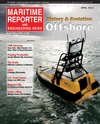
Page 51: of Maritime Reporter Magazine (April 2014)
Offshore Edition
Read this page in Pdf, Flash or Html5 edition of April 2014 Maritime Reporter Magazine
www.marinelink.com 51Saipem?s pipelaying segment is part of a uniÞ ed Business Unit Engineering & Construction, an entity with more than 30,000 employees from more than 100 nationalities, with more than 60 perma-nent establishments and numerous proj-ect execution centers worldwide, which has maintained yearly revenues exceed-ing $13 billion. Saipem is capable of developing proj-ects from feasibility and conceptual studies to complex integrated solutions combining design, engineering, procure-ment, Þ eld construction, fabrication and offshore installation and ancillary ser- vices such as revamps, upgrading, main-tenance, decommissioning, reclamations and decontaminations in virtually every world market. Often this is in remote lo-cations with harsh environmental condi-tions and challenging logistics, through its proven experience across signiÞ cant sectors of the oil and gas industry, such as deepwater O&G transportation via off- shore pipeline systems. Saipem?s ß eet of about 40 offshore construction vessels un- dertake large offshore and subsea instal- lation tasks worldwide, performed either within major complex EPIC projects or as stand alone T&I contracts. ?2014 will be a transition year in which a signiÞ cant proportion of Engineering & Construc-tion activities will stem from low-margin legacy contracts,? said Saipem CEO, Umberto Vergine. In the pipe layer seg- ment, one of Saipem?s main vessels is the Saipem FDS (Field Development Ship), a special purpose vessel used in the de-velopment of deepwater Þ elds, equipped with a dynamic positioning system, a crane with a 600 ton lifting capacity and a vertical pipelaying system capable of operating in water depths of up to 2,000 m (6,561 ft). Deep and ultra-deepwater projects can be tackled by using the J-lay technology on the almost vertical towers of the powerful FDS, FDS2 and Saipem 7000, and by the steep lay of the new company ß agship MV Castorone. Saipem maintains that with the J-lay technology they have available even the depth of the Mariana Trench could be reached or exceeded, with the limit only resting in the line pipe resistance. Looking at the future, Saipem has been strengthening its ß eet by completing the construction of a new state-of-the-art vessel in 2012, the MV Castorone, a deepwater pipelaying vessel for high productivity operations in extreme environments. The extraordinary growth of the world subsea market over the past decade and the rising demand for O&G plays in deep and ultra-deep waters to begin production and for the deep and ultra-deep water drilling to continue in Brazil, the Gulf of Mexico and in West Africa, has led to the development of a range of new offshore Þ eld development and support vessels, including this large new pipelay vessel, currently laying pipe-lines along the GoM.Saipem has been present in Brazil since 1987, and. Saipem do Brasil, founded in 2002, has become one of the leading companies in the Oil and Gas sector in the country. According to a Petrobras En- gineer directly involved in pre-salt O&G transportation projects, who asked to re-main anonymous, ?Saipem was chosen for these projects due to their track record in deepwater projects and their invest-ment in state-of-the-art vessels that are perfect for our deepwater pipeline instal-lation needs. Another major factor weigh- ing in their favor was their willingness to build a yard in Brazil and therefore in-crease the level on local content in their projects.? The integration of the Engi- neering and Projects Center, the company base located in Rio de Janeiro, with the Offshore Construction Technology Cen- ter being built in Guarujá (CTCO), and the use of modern deepwater capable ves-sels offered Petrobras unique advantages and features.Saipem FDS The Saipem FDS mobilized to offshore Brazil in late 2009. The FDS undertook the installation of the Uruguá to Mexil-hao gas trunkline. Stretching more than 170 km (105 miles), this 18-inch gas ex-port line represented Saipem?s Þ rst major trunkline work in Brazil in many years. The Saipem FDS had previously been a mainstay of the West African offshore construction market. The relocation of this vessel highlights the enormous po-tential seen offshore Brazil. The vessel is currently working on a project con-nected to the P-55 production platform at the Roncador Þ eld in the Campos Basin, around 120 km (74.5 miles) off the city of Arraial do Cabo, in Rio de Janeiro. Development of the deepwater Roncador Þ eld is considered to be one of the most challenging projects from the technologi-cal and dimensional points of view, giv- en the depth of the water, which ranges from 1,500 - 2,000 m (4,950 - 6,600 ft.), the size of the Þ eld, which is 111 sq. km (43 sq. mi.) and the characteristics of the hydrocarbons, which are located among high quality siliciclastic rock from the Cretaceous age with average porosities of 25% and average absolute permeabil-Saipem FDS 2 with new J Lay tower at anchor. MR #4 (50-55).indd 51MR #4 (50-55).indd 514/5/2014 3:23:01 PM4/5/2014 3:23:01 PM

 50
50

 52
52
